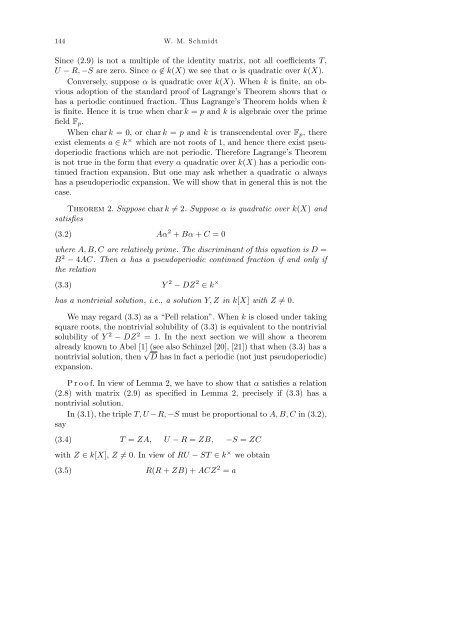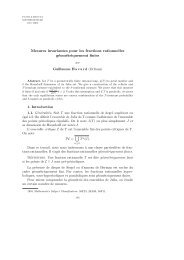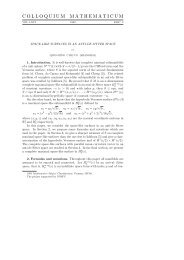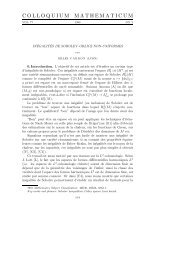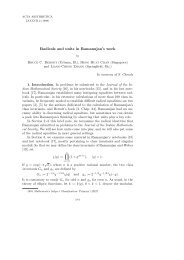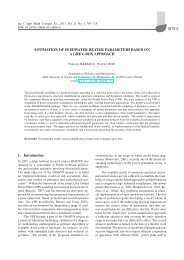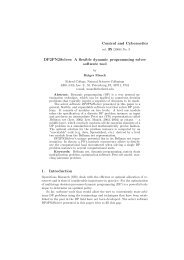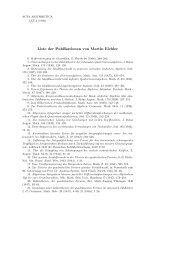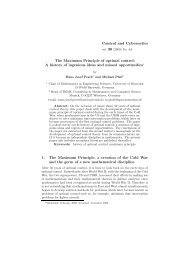On continued fractions and diophantine approximation in power ...
On continued fractions and diophantine approximation in power ...
On continued fractions and diophantine approximation in power ...
You also want an ePaper? Increase the reach of your titles
YUMPU automatically turns print PDFs into web optimized ePapers that Google loves.
144 W. M. Schmidt<br />
S<strong>in</strong>ce (2.9) is not a multiple of the identity matrix, not all coefficients T,<br />
U − R, −S are zero. S<strong>in</strong>ce α ∈ k(X) we see that α is quadratic over k(X).<br />
Conversely, suppose α is quadratic over k(X). When k is f<strong>in</strong>ite, an obvious<br />
adoption of the st<strong>and</strong>ard proof of Lagrange’s Theorem shows that α<br />
has a periodic <strong>cont<strong>in</strong>ued</strong> fraction. Thus Lagrange’s Theorem holds when k<br />
is f<strong>in</strong>ite. Hence it is true when char k = p <strong>and</strong> k is algebraic over the prime<br />
field Fp.<br />
When char k = 0, or char k = p <strong>and</strong> k is transcendental over Fp, there<br />
exist elements a ∈ k × which are not roots of 1, <strong>and</strong> hence there exist pseudoperiodic<br />
<strong>fractions</strong> which are not periodic. Therefore Lagrange’s Theorem<br />
is not true <strong>in</strong> the form that every α quadratic over k(X) has a periodic <strong>cont<strong>in</strong>ued</strong><br />
fraction expansion. But one may ask whether a quadratic α always<br />
has a pseudoperiodic expansion. We will show that <strong>in</strong> general this is not the<br />
case.<br />
Theorem 2. Suppose char k = 2. Suppose α is quadratic over k(X) <strong>and</strong><br />
satisfies<br />
(3.2) Aα 2 + Bα + C = 0<br />
where A, B, C are relatively prime. The discrim<strong>in</strong>ant of this equation is D =<br />
B 2 − 4AC. Then α has a pseudoperiodic <strong>cont<strong>in</strong>ued</strong> fraction if <strong>and</strong> only if<br />
the relation<br />
(3.3) Y 2 − DZ 2 ∈ k ×<br />
has a nontrivial solution, i.e., a solution Y, Z <strong>in</strong> k[X] with Z = 0.<br />
We may regard (3.3) as a “Pell relation”. When k is closed under tak<strong>in</strong>g<br />
square roots, the nontrivial solubility of (3.3) is equivalent to the nontrivial<br />
solubility of Y 2 − DZ 2 = 1. In the next section we will show a theorem<br />
already known to Abel [1] (see also Sch<strong>in</strong>zel [20], [21]) that when (3.3) has a<br />
nontrivial solution, then √ D has <strong>in</strong> fact a periodic (not just pseudoperiodic)<br />
expansion.<br />
P r o o f. In view of Lemma 2, we have to show that α satisfies a relation<br />
(2.8) with matrix (2.9) as specified <strong>in</strong> Lemma 2, precisely if (3.3) has a<br />
nontrivial solution.<br />
In (3.1), the triple T, U −R, −S must be proportional to A, B, C <strong>in</strong> (3.2),<br />
say<br />
(3.4) T = ZA, U − R = ZB, −S = ZC<br />
with Z ∈ k[X], Z = 0. In view of RU − ST ∈ k × we obta<strong>in</strong><br />
(3.5) R(R + ZB) + ACZ 2 = a


